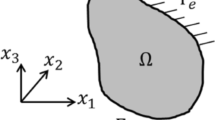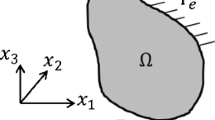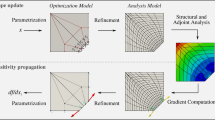Abstract
The calculation of sensitivity of the response of a structure modeled by finite elements to shape variation is known to be subject to numerical difficulties. The accuracy of a given method is typically measured against the yard stick of finite-difference sensitivity calculation. The present paper demonstrates with a simple example that this approach may be flawed because of discretization errors associated with the finite element mesh. Seven methods for calculating sensitivity derivatives are compared for a two-material beam problem with a moving interface. It is found that as the mesh is refined, displacement sensitivity derivatives converge more slowly than the displacements. Six of the methods agree fairly well, but the adjoint variational surface method provides substantially different results. However, the difference is found to reflect convergence from another direction to the same answer rather than reduced accuracy. Additionally, it is observed that small derivatives are particularly prone to accuracy problems.
Similar content being viewed by others
References
Adelman, H.M.; Haftka, R.T. 1986: Sensitivity analysis for discrete structural systems.AIAA J. 24, 823–832
Barthelemy, B.; Chon, C.T.; Haftka, R.T. 1988: Accuracy problems associated with semi-analytical derivatives of static response.Finite elements in analysis and design 4, 249–265
Barthelemy, B.; Haftka, R.T. 1988: Accuracy problems of the semi-analytical method for shape sensitivity calculations of beam-like structures. Paper 88–2284,Proc. AIAA 29th Structures, Structural Dynamics and Materials Conf. (held in Williamsburg, VA, April 18–20)
Choi, K.K.; Seong, H.G. 1986: A domain method for shape design sensitivity analysis of built-up structures.Comp. Meth. Appl. Mech. Eng. 57, 1–15
Dems, K.; Mróz, Z. 1986: On a class of conservation rules associated with sensitivity analyisis in linear elasticity.Int. J. Solids Struct. 22, 737–758
Dems, K.; Haftka, R.T. 1989: Two approaches to sensitivity analysis for shape variation in structures.Mech. Struct. Mach. 16, 465–476
Haftka, R.T.; Grandhi, R.V. 1986: Structural shape optimization- a survey.Comp. Meth. Appl. Mech. Eng. 57, 91–106
Haftka, R.T.; Adelman, H.M. 1989: Recent developments in structural sensitivity analysis.Struct. Optim. 1, 137–151
Kane, J.H.; Saigal, S. 1988: Design sensitivity analysis of solids using BEM.J. Eng. Mech. 114, 1703–1722
Sandridge, C.A.; Haftka, R.T. 1987: Accuracy of derivatives of control performance using a reduced structural model.Proc. AIAA/ASME/ASCE/AHS 28th Structures, Structural Dynamics and Material Conf. and AIAA Dynamics and Material Conf. and AIAA Dynamics Specialist Conf. Part 2B, 622–628
Yang, R.J. 1989: A three-dimensional shape optimization system Shop3D.Comp. Struct. 31, 881–890
Author information
Authors and Affiliations
Additional information
Communicated by J. Sobieski
Rights and permissions
About this article
Cite this article
Haftka, R.T., Barthelemy, B. On the accuracy of shape sensitivity. Structural Optimization 3, 1–6 (1991). https://doi.org/10.1007/BF01743484
Received:
Issue Date:
DOI: https://doi.org/10.1007/BF01743484




